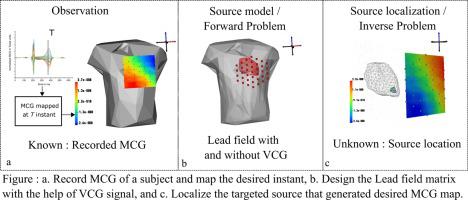IRBM ( IF 4.8 ) Pub Date : 2020-10-26 , DOI: 10.1016/j.irbm.2020.10.004 V.R. Bhat , H. Anitha , K. Gireesan

|
The muscles of the heart are associated with the flow of currents on tissue in the volume conductor formed inside the human body. The electrical currents of the human heart generate a tiny magnetic field beyond the thorax surface. The functional waves generated in terms of the field are detected using Magnetocardiogram (MCG) at the detector level. One of the challenging tasks in the research area is to compute algorithms which help in visualizing/localizing the cardiac anomalies non-invasively at the heart level. In order to localize, a generic model based on prior assumptions is designed which is known as a forward problem. This model depicts the spatial relation between the heart locations and the detectors.
In this paper, a novel method is proposed in the construction of the forward matrix; where the prior heart vectors are constrained with vectorcardiography (VCG) signals. The spatial matrix is subsequently used to estimate the desired position on the myocardium in an inverse way. To evaluate the model, several true prior dipoles are placed on desired positions of the heart each at a time and the inverse problem is solved using multi-start downhill simplex search. The spatial matrices are updated based on VCG during each movement of the test dipoles' positions in the inverse search. The inverse studies are computed and compared between the proposed and the existed methods for the entire cardiac cycle. The performance of the inverse model with unit VCG orientations exhibited an improvement of mm average localization error than the conventional one.
中文翻译:

从心向量图构建动态导联场解决心磁图正反问题
心脏肌肉与人体内部形成的体积导体中组织上的电流流动有关。人类心脏的电流会在胸部表面之外产生一个微小的磁场。在检测器级别使用心磁图 (MCG) 检测根据场产生的功能波。该研究领域的一项具有挑战性的任务是计算算法,这些算法有助于在心脏水平无创地可视化/定位心脏异常。为了定位,设计了基于先验假设的通用模型,这被称为前向问题。该模型描述了心脏位置和检测器之间的空间关系。
本文提出了一种构建前向矩阵的新方法;其中先前的心脏矢量受矢量心电图 (VCG) 信号的约束。空间矩阵随后用于以相反的方式估计心肌上的期望位置。为了评估模型,一次将几个真实的先验偶极子分别放置在心脏的所需位置,并使用多开始下坡单纯形搜索来解决逆问题。在逆向搜索中测试偶极子位置的每次移动期间,空间矩阵基于 VCG 进行更新。对整个心动周期的建议方法和现有方法之间的逆向研究进行计算和比较。具有单位 VCG 方向的逆模型的性能表现出提高了 mm 平均定位误差比常规定位误差大。



























 京公网安备 11010802027423号
京公网安备 11010802027423号